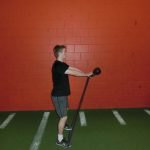3 Of The Top Exercises to Increase Vertical Jump
There aren’t too many athletes that don’t want to increase their vertical jump. Yes, there are sports (basketball, volleyball…) where there are obvious reasons players want to increase their jump, but also nearly every other sport as well because when you really think about it the vertical jump is a measure of how powerful you can move your own body, something nearly all sports require.
There are a lot of details that go into increasing an athlete’s vertical jump. This blog is going to focus on 3 specific exercises that you can do to increase your jump height. It’s not necessarily all the details of the jump technique or instruction but instead, focuses on strength qualities. These 3 exercises have been staples in my programming for years for athletes needing to jump higher. Each one of them will work on a different strength quality as it specifically pertains to the vertical jump.
Exercise: Athletic Hold with Posterior Distraction
Purpose: To teach the glutes, hamstrings, and lower legs how to take in force or “load”. This is a particularly great exercise for athletes that display weakness in their hamstrings when jumping.
How to Perform: Every athlete is going to be different as far as their optimal position, but basically, the athlete should have their shoulders, knees, and toes inline when being looked at from the side. From the front view, the knees should be centered over the second toe and the athlete’s chest should up. Although, this is a great position to have your athlete just hold in general, what will make it one of the top exercises is adding band resistance from the back of the athlete.
Common incorrect positioning to watch for: This exercise is only as effective as the position the athlete is holding. When adding the resistance from the back the tendency of the athlete will be to shift their weight too far back placing their weight on their heels and in turn making their shin have too much of a vertical angle. If you have vertical shins and are on your heels, your knees are not over your toes, therefore, you are not in the loaded position through your glutes and hamstrings, which will not make this exercise effective. To correct this reposition to your optimal position.
Prescription: Hold position for 20-30 seconds, can work up to 1 minute, can also add more band resistance once 20-30 seconds can be held with ease. The number of sets varies on where this exercise is placed in the workout, up to 2-3 sets.
Exercise: ISO-Mid Thigh Pull (IMT Pull)
Purpose: This is a great exercise to increase starting strength as well as concentric lower body power at a given range of motion. Starting strength plays a key role in an athlete’s rate of force development. What is trying to be accomplished with this exercise is to get the athlete to recruit the “deeper” muscle fibers to get the body to move. The body is only going to use the muscle fibers it needs to in order to achieve the task. If the task isn’t being achieved it is going to call upon other muscle fibers to accomplish the task.
How to Perform: In a power rack, the athlete will assume a given position within the jump holding a bar at knee/thigh level (I start with the bottom of the jump). From that position, they will try to drive the rack up against the catch bars lifting with their guts, hamstrings, and lower legs. There should be no joint angle movement while lifting.
Common incorrect positioning to watch for: The vital aspect of this exercise is the position. Once the athlete gets into the correct position for them and starts to lift the rack up, the joint position should not change. Often times you’ll see them shifting the weight to their heels, causing the shin to get vertical (more quad dominant). You will also see an athlete lift with their back when they start to pull, the initial drive should come from their glutes. If the position has been compromised have the athlete reposition to start the exercise again.
Prescription: This exercise should never be held for more than 10 seconds. Sets can range up to 5.
Exercise: Banded Kettlebell Swing
Purpose: Putting this exercise into to your program will get you to have a greater stretch reflex or bouncy feel to your jumps. This exercise will make the athlete more elastic, or in other words, work more like a rubber band.
How to Perform: Attaching a band to the kettlebell will add more speed to the eccentric (stretching) part of the action. As with the other exercises, the position is paramount. It is the action/position at the hip that this exercise is trying to capitalize on. When performing the descent of the KB swing the hip, knee, and ankle relationships have to be one in which it is putting the posterior chain in a greater stretch. This stretch should be maintained and/or become greater through the movement through the transition to the upward action.
Common incorrect positioning to watch for: When adding more speed to the downward action the athlete will tend to compensate their alignment including their knees coming in or leading to far forward. If an athlete can’t hold proper positioning it often times is because it is too great of a tension of the muscle from the more rapid stretch that the band causes. When alignment gets compromised a lighter band needs to be used.
Prescription: 8-12 reps and up to 5+ sets as long as the execution speed is high and does not drop off too much.
As more athletes are coming to the realization that increasing jump height is a vital part of training for their given sport, these 3 exercises can have a great effect on producing the results they want.





